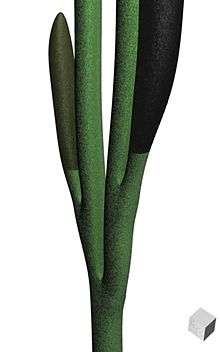Salopella
| Salopella Temporal range: Late Silurian–Early Devonian | |
|---|---|
 | |
| Rough 3D rendering of Salopella. Scale cube: 1 mm | |
| Scientific classification | |
| Kingdom: | Plantae |
| Phylum: | †Horneophyta |
| Class: | †Horneophytopsida |
| Order: | †Horneophytales |
| Family: | †Horneophytaceae |
| Genus: | †Salopella Edwards & Richardson 1974[1] |
| Species | |
| |
Salopella is a form genus for small fossil plants of Late Silurian to Early Devonian age. The diagnostic characters are naked axes branching isotomously, terminating in fusiform sporangia.[1] The sporangia are unbranched, but in at least the type species the axes seem to branch just under the sporangia.[2] It differs from the similar form genus Tortilicaulis in that the sporangia do not have spirally arranged cells, and from other similar form genera such as Cooksonia, Uskiella and Tarrantia in the shape of the sporangia.
Species have been reported from Wales, Xinjiang, Brazil and Australia. Most species are based on very small fragments of the tips of plants, the exceptions being the two Australian species which preserve rather more of the plant. The relationships of the genus are not clear because many anatomical details remain unknown. A useful summary table of what data is known was given by Edwards et al.[3]
References
- 1 2 Edwards, D.; Richardson J.B. (1979). "Lower Devonian (Dittonian) plants from the Welsh borderland". Palaeontology 17: 311–324. http://palaeontology.palass-pubs.org/pdf/Vol%2017/Pages%20311-324.pdf.
- ↑ Edwards, D., Fanning, U. (1985). "Evolution and environment in the late Silurian-early Devonian: the rise of the pteridophytes.". Philosophical Transactions of the Royal Society. B. 309 (1138): 147–165. doi:10.1098/rstb.1985.0076.
- ↑ Edwards, D., Fanning, U., Richardson J.B. (1994). "Lower Devonian coalified sporangia from Shropshire: Salopella Edwards & Richardson and Tortilicaulis Edwards". Botanical Journal of the Linnean Society. 116 (2): 89–110. doi:10.1006/bojl.1994.1055.